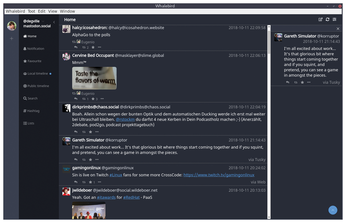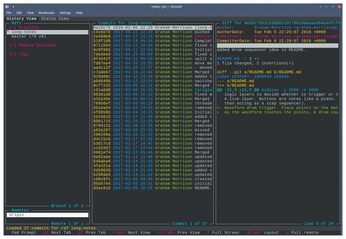FOSSPicks
Whalebird
There's no doubt that the popular social networks are going through something of an identity crisis. After their incredible first flushes of success, we're now at the stage where each is attempting to heavily monetize its user base. This is rightfully waking many users up to how their data is being used. Federated social networks are often touted as the answer, because there's no single gatekeeper to your posts and no one with control over the whole network. But to be useful, a federated network needs to get past the chicken and egg situation of becoming useful before more people join. Mastodon is the current popular federated option, and it does seem to have momentum, at least with the open source and privacy communities. Of the approximate 750 people I follow on Twitter, I found 35 on Mastodon. That's only around 5 percent of an already self-selected bias for this kind of technology, but at least I can finally keep on top of my timeline.
To make all this useful, you need a decent client. Mastodon's web interface has improved hugely recently and will feel familiar to anyone who uses TweetDeck for Twitter. It defaults to a multicolumn view that's most useful to the power user who needs to use many timeline filters. There are several decent command-line clients, too. However, Whalebird, an Electron desktop application, is a great choice if you're just starting out. Like the standard Twitter experience, Whalebird doesn't overwhelm you with options and focuses on your own basic timeline and any community interaction. It looks a lot like the Slack client, for instance, and features decent shortcuts, a dark theme, hashtag views, and lists. If you've been on the fence about using yet another social network, Whalebird could just make the difference.
Project Website

Repository viewer
GRV
So many of us now use git on the command line, it's difficult to contemplate using a GUI tool to make accessing Git repositories easier. The context shift from command line to desktop is often enough to break your train of thought or concentration, but we have covered one helpful command that's worth using, tig, and here's another. GRV (Git Repository Viewer) is a lot more ambitious and effectively builds an entire GUI on the command line around your local Git repositories. The main view, called the History View, consists of three panels. On the left is a pane for branches, tags, and remote references, and in the middle is a list of commits for your chosen branch. The pane on the right side lists the changes, as a diff, for that specific commit. The other view is Status View, which gives an overview of what's changed in your local branch since the last push. If you're already familiar with git, this makes complete sense. It's wonderful to see your work presented in such a clear way, just as you likely imagine the whole repository hanging somewhere.
GRV is also deep. It defaults to using Vim key bindings and makes a wonderful partner to programming in the editor. There's even theme support and the ability to filter through the data using a query language rather than simple searches. In the background, changes to the repository are captured by monitoring the filesystem and update the UI automatically. This means it works well in a separate tmux panel, for example, capturing changes as you make them, or as they're pulled from upstream. Git is complicated; while GRV is never going to make the learning curve any easier, it's a fantastic tool for confirming what you think is happening is actually happening, as well as helping you to visualize how your projects are developing.
Project Website
https://github.com/rgburke/grv

Buy this article as PDF
(incl. VAT)
Buy Linux Magazine
Subscribe to our Linux Newsletters
Find Linux and Open Source Jobs
Subscribe to our ADMIN Newsletters
Support Our Work
Linux Magazine content is made possible with support from readers like you. Please consider contributing when you’ve found an article to be beneficial.

News
-
Linux Servers Targeted by Akira Ransomware
A group of bad actors who have already extorted $42 million have their sights set on the Linux platform.
-
TUXEDO Computers Unveils Linux Laptop Featuring AMD Ryzen CPU
This latest release is the first laptop to include the new CPU from Ryzen and Linux preinstalled.
-
XZ Gets the All-Clear
The back door xz vulnerability has been officially reverted for Fedora 40 and versions 38 and 39 were never affected.
-
Canonical Collaborates with Qualcomm on New Venture
This new joint effort is geared toward bringing Ubuntu and Ubuntu Core to Qualcomm-powered devices.
-
Kodi 21.0 Open-Source Entertainment Hub Released
After a year of development, the award-winning Kodi cross-platform, media center software is now available with many new additions and improvements.
-
Linux Usage Increases in Two Key Areas
If market share is your thing, you'll be happy to know that Linux is on the rise in two areas that, if they keep climbing, could have serious meaning for Linux's future.
-
Vulnerability Discovered in xz Libraries
An urgent alert for Fedora 40 has been posted and users should pay attention.
-
Canonical Bumps LTS Support to 12 years
If you're worried that your Ubuntu LTS release won't be supported long enough to last, Canonical has a surprise for you in the form of 12 years of security coverage.
-
Fedora 40 Beta Released Soon
With the official release of Fedora 40 coming in April, it's almost time to download the beta and see what's new.
-
New Pentesting Distribution to Compete with Kali Linux
SnoopGod is now available for your testing needs

